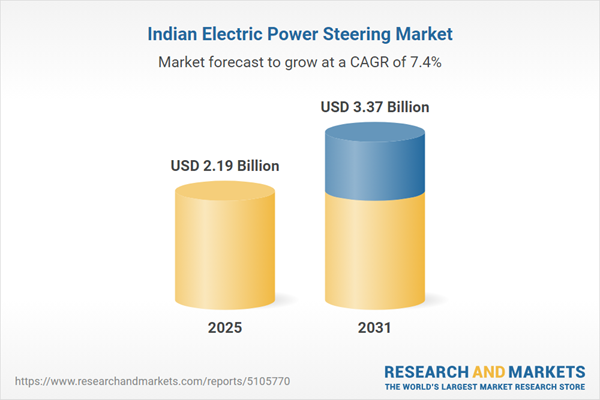Speak directly to the analyst to clarify any post sales queries you may have.
10% Free customizationThis report comes with 10% free customization, enabling you to add data that meets your specific business needs.
Expanding GDP and growing disposable income are leading to increased consumer preference for technologically advanced and feature-rich vehicles, further fueling the demand for EPS-equipped models. For instance, India’s GDP expanded by 6.7% year-on-year in the first quarter of fiscal 2025 (Q2 CY2024), supported by early signs of rural consumption recovery despite mixed overall private consumption trends. However, industrial activity showed signs of deceleration, with the Index of Industrial Production (IIP) easing to 4.2% in June 2024 from 6.2% in May.
Market Drivers
Integration with Advanced Driver Assistance Systems (ADAS)
The increasing incorporation of Advanced Driver Assistance Systems (ADAS) in vehicles is creating a strong demand for intelligent steering solutions like Electric Power Steering (EPS). ADAS features such as lane keeping assist, adaptive cruise control, and automated parking rely heavily on precise and electronically controlled steering inputs, which hydraulic systems are unable to deliver. EPS, being entirely electronic, allows seamless integration with control units and sensors, enabling real-time steering adjustments necessary for driver assistance functionalities.Automakers and technology developers are continuously refining EPS systems to support higher levels of driving automation, making them central to the development of semi-autonomous and autonomous vehicles. For instance, India’s automotive sector is undergoing a pivotal shift with the Ministry of Road Transport and Highways mandating Level 1 ADAS features Advanced Emergency Braking, Driver Drowsiness Warning, and Lane Departure Warning - for new passenger vehicles with more than eight seats and select commercial vehicles starting April 2026, and for existing models by October 2026. This move aims to address India’s high road accident rate and aligns with global safety trends. The mandate is expected to drive major advancements in sensor integration, semiconductor demand, and software localization, supported by government programs.
Key Market Challenges
High Cost of Advanced EPS Technologies
The adoption of Electric Power Steering systems, particularly those integrated with advanced features such as steer-by-wire, torque sensors, and fail-safe mechanisms, often involves significant cost implications for manufacturers. These sophisticated systems require high-precision electronic components, specialized actuators, and robust control software, all of which increase the production cost.For automakers operating in price-sensitive segments, this cost burden can be a major barrier to widespread implementation. While premium vehicles may absorb these expenses more easily, the cost constraints in mass-market models often limit the penetration of high-end EPS variants. This challenge becomes more complex when combined with the need for rigorous testing, regulatory compliance, and integration with existing vehicle platforms. Manufacturers are under pressure to strike a balance between introducing advanced steering technologies and maintaining competitive pricing.
Key Market Trends
Emergence of Steer-by-Wire Systems
Steer-by-wire technology is emerging as a transformative trend in the Electric Power Steering landscape, replacing traditional mechanical linkages with fully electronic control systems. This innovation eliminates the physical connection between the steering wheel and wheels, allowing for greater design flexibility, enhanced safety features, and improved driving dynamics. Steer-by-wire systems enable real-time response customization, torque feedback adjustment, and integration with autonomous driving modules.By removing mechanical constraints, automakers can introduce foldable steering columns or reconfigurable cockpits, enhancing cabin space and user experience. Steer-by-wire also allows for more precise inputs and corrections, crucial for high-level ADAS and automated driving functionality. While the technology is currently seen more in luxury or concept vehicles due to cost and regulatory approvals, its long-term scalability is gaining attention. As system reliability improves and standardization progresses, steer-by-wire is expected to play a central role in shaping future mobility solutions.
Key Market Players
- JTEKT Corporation
- Denso Corporation
- GKN Automotive Limited
- Hitachi Astemo, Ltd.
- Hyundai Mobis
- Mitsubishi Electric Corporation
- Nexteer Automotive
- NSK Ltd.
- Robert Bosch GmbH
- ZF Friedrichshafen AG
Report Scope:
In this report, the India Electric Power Steering Market has been segmented into the following categories, in addition to the industry trends which have also been detailed below:India Electric Power Steering Market, By Vehicle Type:
- Passenger Cars
- Commercial Vehicles
India Electric Power Steering Market, By Type:
- C-EPS
- P-EPS
- R-EPS
India Electric Power Steering Market, By Component:
- Steering Column
- Steering Wheel
- Sensors
- Electronic Control Unit
- Electric Motor
- Bearings
India Electric Power Steering Market, By Region:
- North
- South
- East
- West
Competitive Landscape
Company Profiles: Detailed analysis of the major companies present in the India Electric Power Steering Market.Available Customizations:
With the given market data, the publisher offers customizations according to the company’s specific needs. The following customization options are available for the report.Company Information
- Detailed analysis and profiling of additional market players (up to five).
Table of Contents
Companies Mentioned
- JTEKT Corporation
- Denso Corporation
- GKN Automotive Limited
- Hitachi Astemo, Ltd.
- Hyundai Mobis
- Mitsubishi Electric Corporation
- Nexteer Automotive
- NSK Ltd.
- Robert Bosch GmbH
- ZF Friedrichshafen AG
Table Information
| Report Attribute | Details |
|---|---|
| No. of Pages | 87 |
| Published | August 2025 |
| Forecast Period | 2025 - 2031 |
| Estimated Market Value ( USD | $ 2.19 Billion |
| Forecasted Market Value ( USD | $ 3.37 Billion |
| Compound Annual Growth Rate | 7.4% |
| Regions Covered | India |
| No. of Companies Mentioned | 10 |









